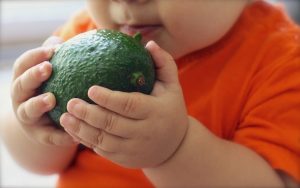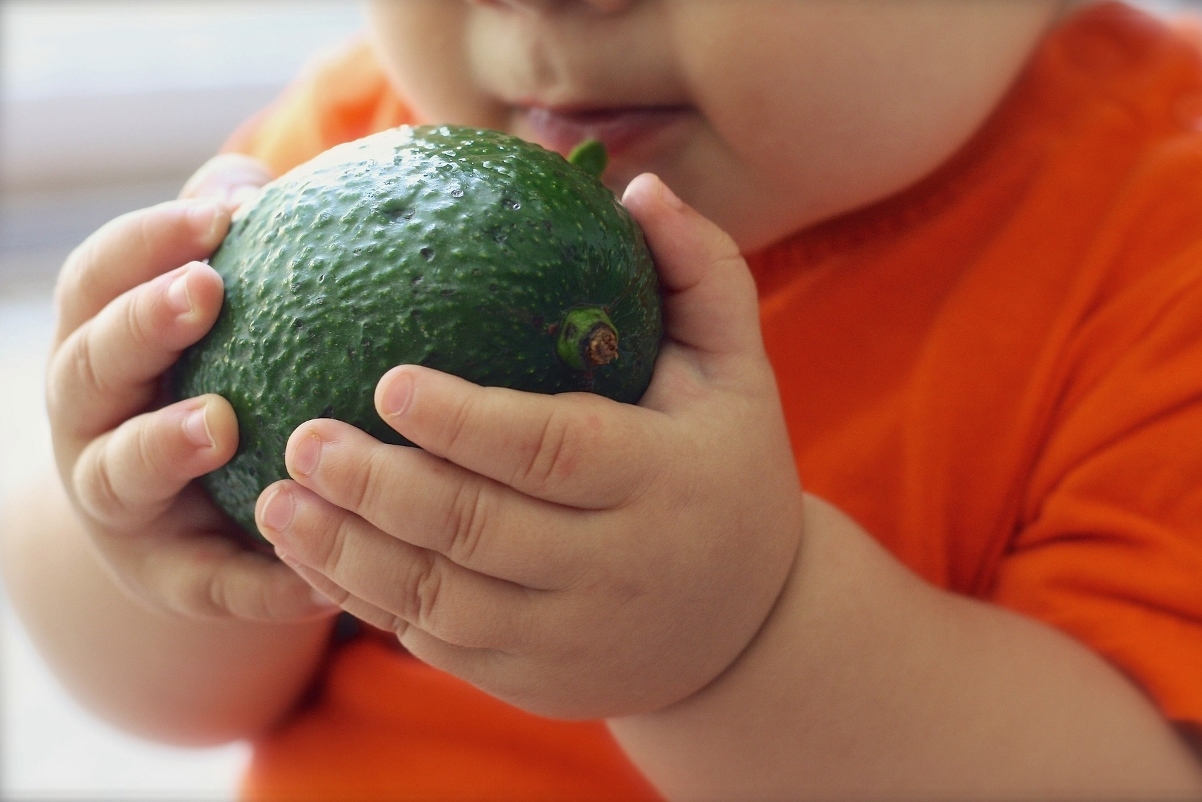 One thing that we can all agree on is that we want the very best for our babies. And it is often hard to figure out what this best might be.
One thing that we can all agree on is that we want the very best for our babies. And it is often hard to figure out what this best might be.
When it comes to introducing first foods, I was brought up to believe grain porridge to be the very best first introduction into the world of solids. I want to share a bit about my experience with my four kids, as well as giving a few tips and ideas for babies’ first tastes.
My first child was a colicky baby, and during the first four months of her life she often had crying spells because of stomach cramps and indigestion. We were out of ideas on how to help her. I tried cutting different foods out of my diet, especially vegetables, and I ended up living on grains. When she was six months old, I started feeding her vegetables, but quickly moved on to gluten-free grains like organic millet, rice and corn, believing that this would help her to be more settled. It did not deliver the results I had hoped. In fact, I now know it just added to her digestive distress. She ended up developing many food sensitivities (e.g. to banana, apple, vinegar, strawberries, dairy and gluten) and regularly got sick with stomach and body pains, fever and vomiting. We had her tested for allergies and the doctors’ advice always was to remove the foods from her diet. I felt very hopeless that in my attempt to raise my child in health, she was having these health challenges.
And then one blessed day, I stumbled upon the book Gut and Psychology Syndrome by Dr Natasha Campbell-McBride, and I had HOPE! The book contains a lot of very good and interesting information (and is a highly-recommended read), but what mostly caught my attention was that food allergies often result from issues in the gut (e.g. leaky gut) and best of all, that the gut can be healed and food allergies reversed! Who knew?! It took me a few months to get my head around the diet, since it was an entire mind-shift from our way of eating at the time, and it sounded like a lot of work. It definitely was hard work to get into, but the journey has been so worth it!
So naturally with my other children, I resorted to doing things differently.
I took Dr Natasha’s advice and started nourishing their guts from the very beginning. Restoring a baby’s gut before potential problems surface saves one a lot of trouble and effort.
There are various research out there stating why it could be unwise to start babies on grains when introducing solid foods. These include research from The Weston A. Price Foundation, Dr Natascha Campbell-McBride and Sally Fallon’s book Nourishing Traditions.
Please note that this post is not to convince anyone as to why they should not give their babies grains first. Instead, it is to share my experience and offer ideas for busy moms on what to feed their little ones should they be looking for alternatives.
The WHEN
Dr Natasha suggests that bottle-fed babies be fed from 4 months old, but breastfed babies can wait until 6 months. You can of course introduce solids earlier if you have a big baby or a very hungry baby.
My children all differed. My last child only really wanted to eat from 9 months old and still does not eat a lot at 2 years of age, even though he has been my biggest baby. He prefers breast milk.
A few indications from your baby when he/she is ready to start eating:
- sitting up on their own;
- losing the tongue reflex that pushes food out of the mouth;
- being able to grab a small object with the thumb and forefinger and bringing it to his/her mouth (basically being able to feed themselves);
- reaching for others’ food or being interested in eating.
The HOW
Below are a few suggestions on nourishing foods to introduce.
1. An extremely nourishing food to introduce first is bone broth. It is super soft on the gut, and nourishes and heals the GI tract. It helps with digestion of food, especially protein and minerals and helps to reduce food allergies.
Bone broth serves as an immune booster and supplies your baby with much needed minerals, amino acids and collagen to build strong bones and teeth.
One way to make this easier is to freeze bone broth in ice tray cubes or little glass pots (just do not fill it up to the top or it might crack) and defrost when needed.
Also make sure that you give the bone marrow from the soup bones to your baby. It can be mixed with the broth and fed with a spoon.
2. Vegetables like squashes, zucchini, carrots, butternut and beetroot cooked with your meat (with the fat on), or in broth or meat stock until very soft. If your baby’s gut is very sensitive, make sure to remove the fibrous parts of the vegetable, like skins, seeds and stalks, and serve mashed (with a tiny bit of coconut oil added), or cut in little blocks so that your baby can eat it with his/her fingers.
Avoid adding spices or salt at this stage.
3. Add fats to every meal. Fats to include: Organic, grass-fed beef or sheep tallow, organic coconut oil, organic cold-pressed olive oil, organic free-range chicken or duck fat and ghee (clarified butter). Fats are very important for your child’s rapidly developing brain and body.
4. A spoonful of ginger, fennel, mint or chamomile tea can be given as a digestive aid.
5. It is important to give a good probiotic to your baby. You can also start adding sauerkraut (fermented cabbage) juice to his/her food to help populate the gut with friendly bacteria.
6. The egg yolk of a soft boiled egg (which is extremely digestible and nutrient rich like breast milk) can be added to food from 5 months old. Make sure not to include the white because that is the part of the egg most people react to.
Before introducing egg yolk, put a little bit of the raw egg yolk on a plaster (not the egg white) on the inside of your baby’s wrist at night. In the morning, take the plaster off. If the skin is red, omit the egg yolk and do the test again in 2 weeks’ time.
It is also advisable that when you do introduce egg yolk, to give your baby only half a teaspoon for the first week to ensure he/she digests it well.
7. After the vegetables have been introduced successfully, introduce a teaspoon of avocado with a meal. If avocado is well tolerated, it is a lovely take-away meal for your baby, high in good fats, dietary fibre, vitamin K, copper, folate, vitamin B6, potassium, vitamin E, and vitamin C.
8. Soft-cooked apple or pear with coconut oil can be given as a snack if all the vegetables are tolerated well. It is recommended that fruits be eaten between meals so that it does not interfere with the digestion of meats (when having your meats during meals).
9. Next, raw carrot can be juiced and a teaspoon given, or it can be grated finely into food.
10. Pureed liver from organic pasture-raised animals can be given in small amounts mixed into vegetables. Liver is a powerhouse of nutrients which is exactly what your baby needs to grow well.
11. Broccoli, cauliflower and green beans cooked in bone broth until soft. Given whole to eat makes for a lovely finger-food for your baby.
12. Soft, fatty, gelatinous meat can be introduced in small amounts. It should be simmered on low heat until it falls off the bone. If your baby is constipated, add more fat to the food or try the meat at a later stage again. It worked best for me to puree the meat with the vegetables, to prevent them from swallowing big pieces that is hard on the digestion.
13. If there are no dairy sensitivities in your family, you can add a teaspoon of raw milk kefir or preferably homemade yoghurt made from organic milk of pasture-raised cows.
14. When all is well tolerated, fresh vegetables like cucumber can be introduced.
15. Raw fruit, like mashed banana and grated apple, served with avocado.
Some additional tips
- It is always best to let your baby choose between the foods. If he/she does not want to eat something, try it again at a later stage. A baby knows what his/her body needs.
- Heating food without using a microwave: Let a dish stand in a bowl filled with boiled water. It will heat up quite quickly.
- Use two spoons when feeding. One for you to feed your baby and the other to give to him/her to play with.
- Food can take up to 3 days to show a reaction in the body, so make sure you introduce different foods three or more days apart. Look out for changes in the consistency (loose or constipated), colour or smell of the stool or any skin rash or eczema flare-up on the body. If there is a change, remove the food from the diet and introduce it again later.
- And then remember to enjoy this wonderful stage of exploration and growth. It is important that food is eaten with gratitude and positive thoughts, as this also plays a role in how your body receives and digests it. Make sure your little one enjoys the process, and associates joy with eating healthily.
And finally, you might wonder what happened to my eldest daughter’s allergies. After 3 years on the GAPS diet, she is allergy-free! She loves strawberries, vinegar, apple and all the rest. One of her favourite treats is our Vanilla Apple Cake, which she would never have been able to have before. She is still slightly sensitive to dairy with the symptom of a stuffy nose, but she can eat raw dairy without getting sick like before.
Great things happen when we take responsibility for our own health and I hope this leaves you inspired to do so!
To life and in good health,
Franzelle


I want to do GAPS diet as my eldest has a few food sensitivities that shows up as eczema. But really struggling with making it interesting for him. Can you maybe give some tips on breakfast lunch and dinner ideas. Thanks!
Great question and definitely a topic we will post about in the near future. It does take a while for the taste buds to adjust to the new way of eating, though.